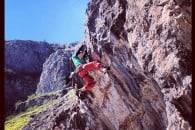
I'm sure we can all remember our first pair of climbing shoes – they were comfy weren't they? I remember my first pair coming to the end of the road and being genuinely sad. They were so "good".
But they weren't…
A first-time climber, beginner or even an "improver" (climber) are all easy to spot at the climbing wall. They are either wearing hire shoes or baggy shoes (or both).
Now, when it comes to good footwork, two of the most important aspects are precision and accuracy. The next, pressure. We will explore these aspects in the next videos, but it is simply impossible to place a toe carefully, precisely and beyond all – trust it, with baggy or large shoes.
When watching this video, please don't think there is anything wrong with a hire shoe or a flat "first-time" shoe. They have their place. But, don't buy them with excess space. Don't liken them to trainers or our day-to-day shoe. They must be well fitted – with no excess space. Toes should be touching the end and arguably slightly bent too. This allows us to apply more pressure through the big toe – think full-crimp vs the open-hand grip.
Having spent a fair bit of time with the designers of many shoes, from many brands, they are all adamant about this point. Can you step on a tiny gritstone pebble with a shoe that has space in it? No. Can you really trust your shoe on a 5mm Limestone edge in a shoe that is too "comfy"? No.
Technique is all about efficiency and ultimately, taking the weight off our weakest points – fingers and forearms. If you have shoes that don't fit properly, the weight will go onto your arms because you cannot trust your feet. You will be firing too much, burning out too quickly and you simply will not progress as you want to.
Your first pair of shoes will go through faster than any other, so don't buy the "best", downturned and aggressive shoes. It will be a waste of money. But, do buy them so they are snug. Your foot should completely fill the shoe. It should be tight, arguably slightly uncomfortable to begin with. They may take a few sessions to wear them in but anticipate stretch.
The next five videos will explore what it means to have good footwork. From precision and accuracy, to the position of your heels, pivoting, smearing, toe and heel hooks.
I guarantee there will be elements you have not thought about before, and they will help your footwork and your overall climbing.
Enjoy, and let me know what else you want us to explore beyond footwork and tutorials in drop-knees, the step-through, rock-overs and the inside and outside flag?
Robin O'Leary is a full-time performance coach. He has been working as such for the last 10+years and now works with some of the best-performing athletes in the UK.
Robin is the head coach of the GB Para-Climbing Team and has coached National, European and World Champion climbers. Along with working with top-level athletes around the world, Robin also coaches hundreds of keen enthusiasts. From hands-on technical coaching, to long-term programme work.
Robin is also the co-author of UKClimbing's highly successful Injury Management and Prevention articles.
If you want to get in touch with Robin, please visit his website:












Comments
Back in 1995 I tried to onsight Entropy's Jaw in my brand new tight fitting lasers and fell twice just before the gear. I then tried to top rope it and still failed. As we were packing up to go home I decided to try again in my old, baggy, resoled lasers and I soloed it easily first go. The same thing happened on a different Roaches slab some time later. (can't remember which one). I'd fallen a few times in my new shoes, borrowed a friend's old and baggy original style ninjas and climbed it easily straight away. Tight new shoes aren't necessarily always the best shoes.
One "Dislike" already? Good grief.
Okay, another time I was in the South of France, completely failing to get anywhere on a bolted 7b+ in my very tight (but not very stiff) shoes. I had a rest, borrowed my brother's brand new stiff shoes that were a size too big and cruised it straight away.
Isn’t the moral of the story pick the right tool for the job?
Very true in the fact that a "brand-new shoe" can be too stiff - depending on the model. Today, even the most aggressive performance shoes can be ideal for smearing and edging straight out of the box. Overly tight isn't a good thing - but too loose is the point I want to make here. The key is that so many people are climbing in shoes that simply inhibit performance. I have coached literally thousands of climbers over the last 12 years. I have worked in climbing walls everyday for that time too and spent more time outside than most. I see that the message that a lot of shops are sending out is incorrect. The shoe designers support this sentiment too.
Yes, but that isn't something that might be tight or painful.
It's also dependant on what you want out of climbing, if you're striving for grades then fair enough, ram you feet into tiny painful foot prisons and get on with it. If you want to spend all day climbing a number of different routes, in good company and simply "doing stuff in nature" then comfy is the way to go.
There's a lot of bullshit regarding shoes and comfy is often seen as slack, sloppy and inferior, it doesn't have to be any of those.